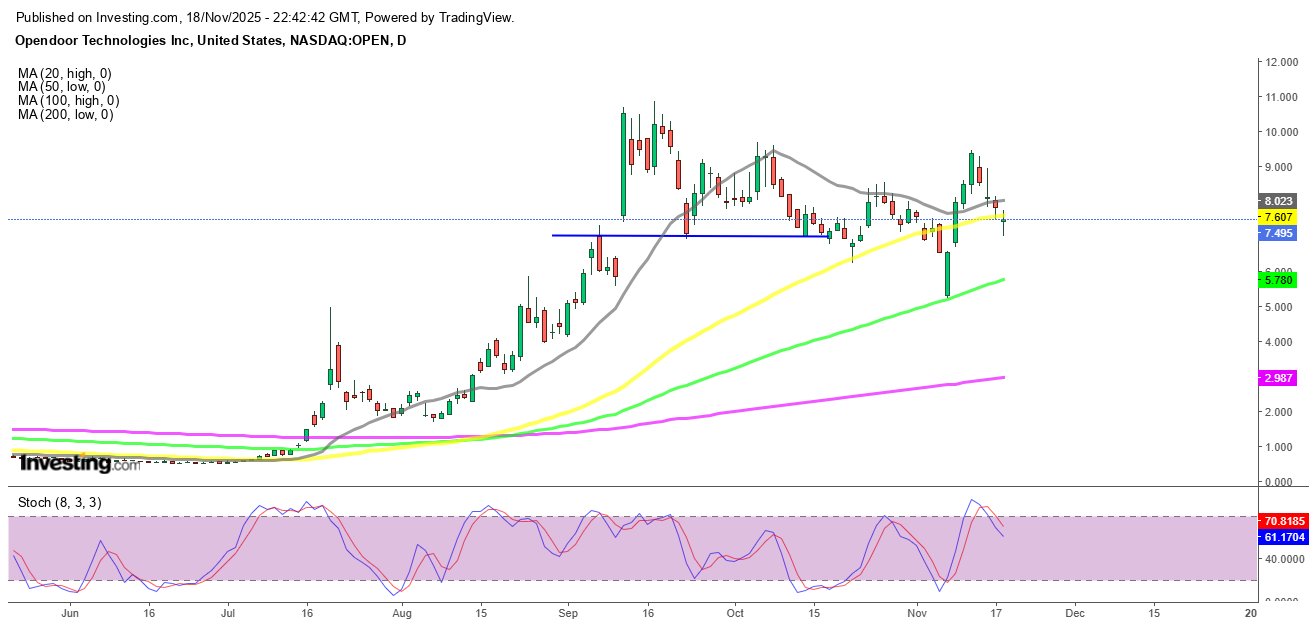OPEN Stock Tumbles Below Support Pre Dividend, Despite Insider Buying
Opendoor’s once-explosive rebound is losing steam fast as deepening losses, dilution risks and shifting rate expectations weigh on the stock

Quick overview
- Opendoor's stock has sharply declined from a peak of nearly $11 in September due to deepening losses and changing market conditions.
- The company's recent rebound was fueled more by speculative enthusiasm than by solid fundamentals, leading to a quick loss of momentum.
- Weak financial results, including a widening net loss and declining revenue, raise concerns about the sustainability of Opendoor's business model.
- With macroeconomic pressures intensifying, the stock faces significant technical risks that could lead to further declines.
Opendoor’s once-explosive rebound is losing steam fast as deepening losses, dilution risks, and shifting rate expectations weigh on the stock.
Opendoor’s Rebound Unravels as Market Confidence Weakens
Opendoor Technologies (NASDAQ: OPEN) has gone from one of 2025’s most dramatic comeback stories to one of its most troubling reversals. After almost touching $11 in September—thanks to falling mortgage rates and revived investor optimism—the stock rolled over sharply. Though OPEN briefly recovered last week, bouncing from $5.20 to $9.45 on the back of a modest $1 million insider purchase and CEO-driven warrant announcements, the rebound has already lost momentum.
OPEN Chart Daily – Returning Below the 50 SMA Again
Shares slid 4% during Tuesday’s session and another 3% in after-hours trading, as broader macro pressures intensified following fresh signals from the Federal Reserve that further rate cuts may be halted. For a company that depends heavily on housing-market tailwinds, the shift in tone from the Fed could not come at a worse time.
A Comeback Fueled by Hype More Than Stability
Opendoor’s giant swing from $0.50 in June to $10.85 in early October was nothing short of speculative mania—a 2,000% surge built on retail enthusiasm, social-media hype, and aggressive dip-buying rather than durable fundamentals. While improving mortgage-rate expectations temporarily boosted sentiment, the underlying business remained strained.
Once the initial euphoria faded, reality kicked in. The stock slid for weeks as profit-taking collided with weak operating results. The latest quarterly report only reinforced concerns: widening losses, shrinking margins, and declining revenue—a trifecta that raises doubts about Opendoor’s ability to maintain its comeback narrative.
Temporary Bounce Masks Deeper Structural Issues
The stock’s recent rebound—triggered by support at the 100-day simple moving average—proved short-lived. Traders briefly latched onto CEO Kaz Nejatian’s announcement of warrant distributions intended to pressure the 22% short interest. The distribution offers one K, A, and Z warrant for every 30 shares, with strike prices at $9, $13, and $17.
While marketed as a “short squeeze catalyst,” the plan also underscores a less flattering reality. Opendoor is leaning on financial engineering rather than operational strength. Moreover, issuing warrants adds future dilution risk for regular shareholders—a concern that became more pronounced once the stock resumed its decline.
Weak Financials Expose Fragile Business Model
The company’s Q3 results paint a discouraging picture:
- Net loss widened 15% to $90 million, up from $78 million
- Gross profit collapsed 37%
- Revenue fell 33% to $915 million, despite beating lowered guidance
The sharp deterioration in fundamentals raises questions about whether Opendoor’s tech-powered housing model is sustainable in a volatile rate environment.
Technical Pressure Builds as Macro Conditions Turn Hostile
With OPEN now sliding again, chart risks are mounting. The failed breakout above the 20-day SMA and renewed selling pressure point toward a possible retest of the 100-day SMA, where the stock recently found support.
But if the Fed pauses rate cuts—as hinted this week—housing affordability could weaken again, undermining Opendoor’s entire business thesis. In such a scenario, the support level may not hold for long.
- Check out our free forex signals
- Follow the top economic events on FX Leaders economic calendar
- Trade better, discover more Forex Trading Strategies
- Open a FREE Trading Account
